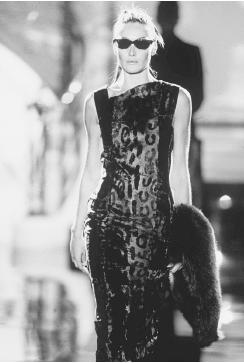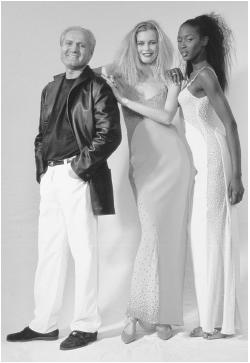Gianni Versace - Fashion Designer Encyclopedia
Italian designer
Born: Reggio Calabria, Italy, 2 December 1946. Education: Studied architecture, Calabria, 1964-67. Family: Brother Santo, sister Donatella, and four nieces and nephews. Career: Designer and buyer in Paris and London, for his mother's dressmaking studio, 1968-72; freelance designer, Callaghan, Complice, Genny, Milan, 1972-77; formed own company, Milan, 1978; showed first womenswear collection, 1978, first menswear collection, 1979; signature fragrance introduced, 1981; home furnishings collection launched, 1993; launched Blonde fragance and opened New York flagship store, 1996; introduced V2 diffusion line for 1997; firm continued after his death by siblings Donatella and Santo; Donatella took over designing duties, 1997; formed joint venture with Sunland Group for luxury hotels,

Publications
By VERSACE:
Books
Vanitas: lo stile dei semsi, with Omar Calabrese, Rome 1991.
Versace Signatures, with Omar Calabrese, Rome 1992.
Gianni Versace, with Bruce Weber, Milan, 1994.
Men Without Ties, with Hannah Barry, New York, 1994.
Rock & Royalty, Milan, 1996.
The Art of Being You, with Germano Celant, New York & Milan, 1997.

On VERSACE:
Books
Alfonso, Maria-Vittoria, Leaders in Fashion: i grandi personaggi della moda, Bologna, 1983.
Giacomondi, Silvia, The Italian Look Reflected, Milan, 1984.
Soli, Pia, Il genio antipatico [exhibition catalogue], Venice, 1984.
Palais Galliera Musée de la Mode, Gianni Versace: dialogues de mode [exhibition catalogue], Milan, 1986.
Pasi, Mario, Versace Teatro (two volumes), Milan, 1987.
Bocca, Nicoletta, and Chiara Buss, Gianni Versace: l'abito per pensare, Milan, 1989.
Martin, Richard, and Harold Koda, Infra-Apparel, New York, 1993.
——, Orientalism: Visions of the East in Western Dress [exhibition catalogue], New York, 1994.
Turner, Lowri, Gianni Versace: Fashion's Last Emperor, London, 1997.
Martin, Richard, Gianni Versace, [exhibition catalogue], Metropolitan Museum of Art, New York, 1997.
Martin, Richard, and Sophie Léchauguette, Gianni Versace, Paris, 1997.
Avedon, Richard, The Naked & the Dresses: Twenty Years of Versace, London, 1998.
Casadio, Mariuccia and Samuele Mazza, Versace, London, 1998.
Mason, Christopher, Undressed: A Biography of Gianni Versace, London, 1999.
White, Nicola, Versace, London, 2000.
Articles
Carlsen, Peter, "Gianni Versace: Disciplined Negligence," in GQ, August 1979.
Withers, Jane, "The Palace of Versace," in The Face (London), December 1984.
Simpson, Helen, "Gianni Versace: ordito e trama," in Vogue (Milan), October 1985.
Petkanas, Christopher, "A Dialogue with Gianni Versace," in WWD, 22 October 1986.
Del Pozo, Silvia, "Gianni Versace: l'immigrato eccellente," in L'Uomo Vogue (Milan), October 1987.
Phillips, Kathy, "The Satanic Versace," in You, magazine of the Mail on Sunday (London), 19 March 1989.
Martin, Richard, "Sailing to Byzantium: A Fashion Odyseey, 1990-91," in Textile & Text, 14 February 1991.
Servin, James, "Chic or Cruel? Gianni Versace's Styles Take a Cue from the World of S&M," in the New York Times, 1 November 1992.
Morris, Bernadine, "The Once and Future Versace," in the New York Times, 8 November 1992.
"Gianni Versace," in Current Biography, April 1993.
Schiff, Stephen, "Lunch with Mr. Armani, Tea with Mr. Versace, Dinner with Mr. Valentino," in the New Yorker (New York), 7 November 1994.
Forden, Sara Gay, "Very Versace: Making America No. 1," in WWD, 1 November 1994.
Gandee, Charles, "Versace's Castle in the Sand," in Vogue, December 1994.
Menkes, Suzy, "Versace's Pastiche Amid Couture Upheaval," in the International Herald Tribune, 23 January 1995.
Spindler, Amy M., "Versace: Clean and Mean for Fall," in the New York Times, 8 March 1995.
"Gianni Versace: The Right Stuff," in WWD, 8 March 1995.
Van Lenten, Barry, "Gianni's American Dream," in WWD, 10 April 1995.
"Gianni vs. Giorgio: Is fashion dead?" in WWD, 11 September 1996.
Sullivan, Ruth, "High Fashion and a Head for Figures (Profile of Santo Versace)," in the European 12 June 1997.
Porter, Henrym and Susannah Barron, "A Tribute to the King of Glamour," in The Guardian, 16 July 1997.
Marlow, Michael, et al., "Fashion World Mourns Loss of a Leader," in DNR, 16 July 1997.
Socha, Miles, "The Versace Legacy," in DNR, 16 July 1997.
Reed, Paula, et al., "Fashion Victim," in the European, 17 July 1997.
Forden, Sara Gay, "Versace: The Milan Farewell," in WWD, 23 July 1997.
Bellafante, Ginia, "La Dolce Vita: Gianni Versace," [cover story] in Time, 28 July 1997.
Foley, Bridget, "Donatella's First Collection," in WWD, 1 October 1997.
Costin, Glynis, "Gianni Versace: A Reflection on Pride, Honesty, and Women," in WWD, 13 September 1999.
Spindler, Amy M., "The Great Gianni," in the New York Times, 18 February 2001.
"The Renaissance of Gianni Versace," in the Economist, 7 April 2001.
***
Gianni Versace's work was both metaphorical opera and real clothing, the first in its larger-than-life exuberance and design bravura and the latter in its unpretentious, practical application to the comfort of the wearer and the expressiveness of the body. Versace made all the world a stage for flamboyant and fascinating costume with the knowledgeable pageantry of the Renaissance, a Fellini-like sensuality of burlesque, and the brilliant notes of operatic color and silhouette. Richly cultivated in historical materials and vividly committed to the hedonism of late 20th-century culture, Versace created distinctive, at-the-edge designs that achieved the aesthetic limit of the avant-garde and the commercial success of viable apparel.
Versace expressed his admiration for Poiret, the fashion revolutionary who in a brief éclat of design genius combined a theatrical fantasy with legerdemain eclecticism. Similarly, Versace functioned as a kind of impresario to his own style, commanding authority over his image and advertising, menswear, womenswear, and accessories. His apparel design was characterized by a particular interest in bias, itself a means of revealing the body in dramatic, sexy clothing for women. His embroideries (and metal mesh) harkened back to the art déco, but were as mod as magazine covers. Likewise, his fascination with black-and-white grids and alternations recalled the 1920s and 1930s.
His abundant swathings suggested Vionnet, Madame Grés, and North Africa. Line was important, with many Versace suits, dresses, and coats marked by lines as if the bound edges of fabric would in outline define waistlines, shoulders, or center front. Like any great showman on stage, Versace was also concerned with metamorphic clothing; that which could be worn or perceived in several different ways. In these respects, it is clear the Milanese designer looked to Tokyo as well as to Milan and Paris. His metallics, trousers for women (ranging from voluminous pantaloons to cigarette-trouser leg wrappings), leather for women, and chunky, glittery accessories have created an image of women as a cross between Amazon and siren.
The boldness of silhouette in his womenswear was only reinforced in his work with photographers to represent the clothing, generally against a pure white field to grant further starkness and aggressiveness. But, in person and in the individual item, Versace's clothing was far less diva and dominatrix than it might seem. Versace's jewel-like colors, his geometric line in pattern, his recurrent fascination with the asymmetrical collars engendered by bias, and his flamboyant juxtapositions of pattern were all elegant traits. Likewise, Versace employed luxurious textiles, classical references, bias cut, and such combinations as leather reversible to wool, and embroidery-encrusted bodies and soft flowing skirts, to his unmistakable fashion.
Versace's menswear was also accented by leather, body wrapping for sensuality, audacious silhouette, and oversizing for comfort. Even in menswear, Versace played with asymmetry and the bias-influenced continuous rotation around the body, rather than a disjunctive front and back. Versace's menswear in particular was sometimes criticized as being futuristic with its big shoulders and technological detailing seeming to suggest science fiction. Yet Versace employed the most elegant menswear materials in a loose, capacious drape defying any space-age references. His designs did, however, recall a futurist ideal of clothing fully realized for the first time with sensuality and practicality.
Versace was an encyclopedist of classical tradition. His insistence upon directing all aspects of his fashion, from publicity and his books to the exhibitions interpreting his work reflected a consummate craftsman. Versace was neither a secluded scholastic, though, nor merely the glittery dresser of stars and celebrities some have perceived. The truth was somewhere in between, in a design imagination of brilliant theatrical insight, probing and analytical interest in bias, and a desire to reconcile the use of fashion history with making apparel appropriate for today.
After overcoming cancer of the lymph nodes, Versace was facing life with renewed vigor. Yet on the morning of 15 July 1997, a gunman named Andrew Cunanan, after a multi-state killing spree, shot Versace on the steps of his Miami home. The fashion industry united in outrage and grief and Versace stores were shuttered for a day in his memory. Donatella and Santo vowed to carry on in their brother's name, releasing a statement that read, "It must be remembered that Gianni Versace stood for the future, and so, of course, we stand dedicated to the future of our company." And so they soldiered on, building the Versace business to new heights amidst the tragedy.
By the year 2000, three years after Gianni's death, the Versace empire had been reorganized, streamlined, and poised for a possible initial public offering. Though Gianni was prepared to take the firm public in 1997, the plans had been tabled after his death. On the design front, Donatella's expertise grew with each succeeding collection, maintaing the Versace sensationalism and colorful style. In addition to the evolving apparel and accessories offered with the Versace label, the firm's name became associated with luxury hotels and resorts through an alliance with the Sunland Group. Gianni's former South Beach home in Miami, was also turned into a hotel.
—Richard Martin;
updated by Sydonie Benét
Comment about this article, ask questions, or add new information about this topic: